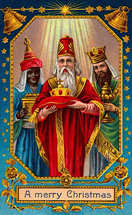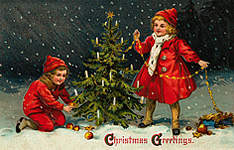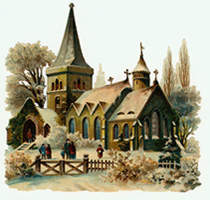The custom of sending Christmas cards started in the UK in 1843 by Sir Henry Cole. He was a civil servant (Government worker) who was very interested in the new ‘Public Post Office’ and wondered how is could be used more by ordinary people.
Sir Henry had the idea of Christmas Cards, and with his friend John Horsley who was an artist, they designed the first card and sold them for 1 shilling each. (That is only 5p today(!), but in those days it was worth much much more.)
The first post that ordinary people could use was started in 1840 when the first ‘Penny Post’ public postal deliveries began. Before that, only very rich people could afford to sent anything in the post. The new Post Office was able to offer a Penny stamp because new railways were being built. These could carry much more post than the horse and carriage that had been used before. Also, railway trains could go a lot faster. Cards became even more popular in the UK when they could be posted in an unsealed envelope for one halfpenny - half the price of an ordinary letter.
 As printing methods improved, Christmas cards became much more popular and were produced
in large numbers from about 1860. An engraved card by the artist William
Egley, who illustrated some of Charles Dickens’s books, is on display
in the British Museum. By the early 1900s, the custom had spread over
Europe and had become especially popular in Germany.
As printing methods improved, Christmas cards became much more popular and were produced
in large numbers from about 1860. An engraved card by the artist William
Egley, who illustrated some of Charles Dickens’s books, is on display
in the British Museum. By the early 1900s, the custom had spread over
Europe and had become especially popular in Germany.
 The first cards usually had pictures of the Nativity scene on them. In late Victorian
times, robin (an English bird) and snow-scenes became popular because
the postmen in that time were nicknamed ‘Robin Postmen’ because
of the red uniforms they wore. Snow-scenes were popular because they reminded
people of the very bad winter that happened in 1836.
The first cards usually had pictures of the Nativity scene on them. In late Victorian
times, robin (an English bird) and snow-scenes became popular because
the postmen in that time were nicknamed ‘Robin Postmen’ because
of the red uniforms they wore. Snow-scenes were popular because they reminded
people of the very bad winter that happened in 1836.
In the 1910s and 1920s, home made cards became popular. They were often unusual shapes and had things such as foil and ribbon on them. These were usually too delicate to send through the post and were given by hand.
 Nowadays, cards have all sorts of pictures on them: jokes, winter pictures,
Father Christmas,
or romantic scenes of life in past times. Charities often
sell their own Christmas Cards as a way raising money at Christmas.
Nowadays, cards have all sorts of pictures on them: jokes, winter pictures,
Father Christmas,
or romantic scenes of life in past times. Charities often
sell their own Christmas Cards as a way raising money at Christmas.
Charities also make money from seals or stickers used to seal the card envelopes.
This custom started in Denmark
in the early 1900s by a postal worker who thought it would be a good way
for charities to raise money, as well as making the cards more decorative.
It was a great success: over four million were sold in the first year!
Soon Sweden
and Norway
adopted the custom and then it spread all over Europe and to America.